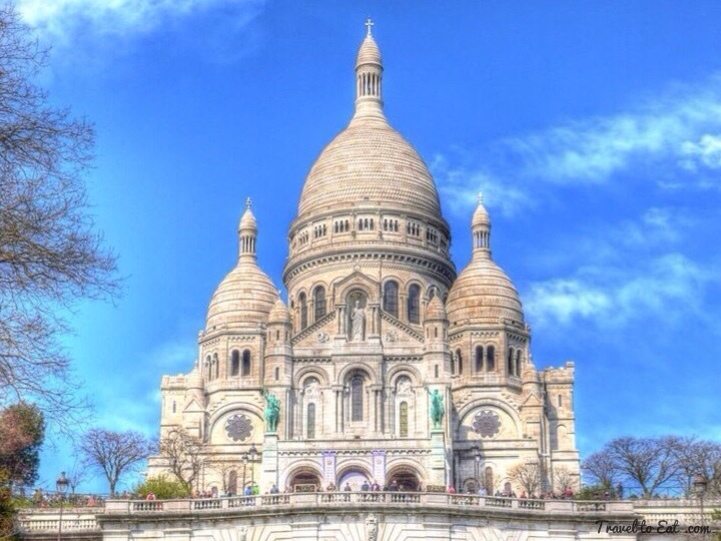
It was a beautiful, sunny spring day, so we decided to go to Montmartre for some fresh air. The word Montmartre is translated to mean “mountain of the martyr” and was derived from the martyrdom of Saint Denis, the bishop of Paris, who was decapitated on the hill in 250 AD. Montmartre's most recognizable landmark is the Basilica Sacré-Coeur, constructed from 1876 to 1912. The white dome of this Roman Catholic basilica sits at the highest point in the city, at the summit of the “butte Montmartre” and the church is visited by millions of tourists each year. This hill outside the city was settled because, during the 19th century, Haussmann under Napoleon III redeveloped Paris and gave much of the prime land inside the city to his wealthy friends, who were charged with the task of developing it. The original inhabitants were forced to move to Paris's outskirts where they quickly established their own “town” without the rules and regulations of the city.


Montmartre is one of the best places to get a panoramic view, located in the north of Paris, about 430 feet (130 meters) high. It gives its name to the surrounding district, in the 18th arrondissement, a part of the Right Bank, including the Pigalle district. Pigalle is famous for being a tourist district, with many sex shops on Place Pigalle and the main boulevards. It is home to some of Paris' most famous cabarets (Moulin Rouge, for instance, was immortalized by artist Toulouse-Lautrec as well as Hollywood), as well as topless and nude shows. Montmartre is the one of the highest points in the city of Paris and from the top you get the great view shown above. As you can see, on a nice day it is a very popular destination for both tourists and locals to take in the sun, shop and eat.

If you are feeling energetic you can take the stairs, be warned, the stairs seem to go on forever.

Fortunately there are little stops along the way and the entire hill is covered with grass almost like a giant park on a slant. Especially on the weekend it is covered with people having a picnic or just enjoying the view while they rest enough to climb more stairs.

The alternative is to pay about a euro and ride up the funicular. I must admit, that is what we did.

There is also a little train, Le Petit Train de Montmartre, which you can get for 6€ which allows you to ride up and back and even includes a little tour of the area. You can get off if you like, and get back on another train to go back down. They come about every half hour.


Once you get to the top, you enter into the chaos. Hundreds of people and tour groups visiting the Sacré-Coeur Basilica, Place du Tertre where the artists paint and of course looking for souvenirs and something to eat and drink. The art comes in all genres, mostly tourist subjects, you can even get your portrait drawn or painted. The artists are a reminder of Montmartre's past artistic traditions. During the mid to late 1800s, many artists began calling Montmartre home. Pissarro and Jongkind were two of the first to live there, followed by such famous artists as Edgar Degas, Henri Matisse, Toulouse-Lautrec, Pierre-Auguste Renoir, and Pablo Picasso, just to name a few.

Sacré-Cœur is a double monument, political and cultural, both a national penance for the supposed excesses of the Second Empire and socialist Paris Commune of 1871, crowning its most rebellious neighborhood, and an embodiment of conservative moral order, publicly dedicated to the Sacred Heart of Jesus, which was an increasingly popular vision of a loving and sympathetic Christ. After France's 1870 defeat by the Prussians, the basilica was planned as a votive offering to cure France's misfortunes. Construction began in 1876, although the church wasn't consecrated until 1919. The mosaic in the apse, entitled Christ in Majesty, created by Luc-Olivier Merson, is among the largest in the world. The basilica complex includes a garden for meditation, with a fountain.



The top of the dome is open to tourists and affords a spectacular panoramic view of the city of Paris, which is mostly to the south of the basilica. Needless to say we did not march up the stairs to the top. The use of cameras and video recorders are forbidden inside the Basilica. It is ok to take pictures on the outside though, the bronze statues are a favorite subject. The Sacré-Coeur Basilica is built of Château-Landon (Seine-et-Marne) stone, a frost-resistant travertine that bleaches with age to a gleaming white. The main portal has grand bronze doors with foliage designs.

Montmartre is very picturesque in places and a little grubby in others with lots of graffiti.



You can see several landmarks from the top, the picture above shows the Tour Montparnesse and the Eiffel Tower. As of August 2012, Tour Montparnesse is the 14th tallest building in the European Union and the second highest point in Paris at 758 feet (231 meters). There is an observation deck on top and a restaurant that is currently closed for renovations. The little graphic above from Wikipedia shows the relative heights of some of the tall structures in Paris.



When you get back to the bottom you can either mingle in with the crowds or enjoy the park at the bottom, complete with carousels. All said, a day at Montmartre is just a relaxing and family friendly fun thing to do in Paris. If you come on a sunny day, you have to check it out.
References:
Le Petit Train de Montmartre: http://www.promotrain.fr/
Sacred Destinations Sacré-Coeur: http://www.sacred-destinations.com/france/paris-sacre-coeur
Sacré-Cœur: http://www.sacre-coeur-montmartre.com/us/index.html

